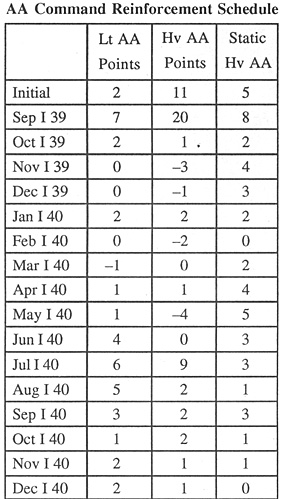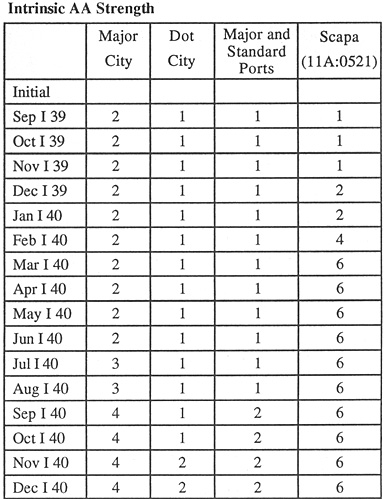Prompted by the article on the British Army order of battle published in TEM 26, I decided to write this article to expand the OB to cover the forces of Britain's AA Command during the same period and fill another small gap in Europa's coverage of British forces.
The regular army anti-aircraft forces consisted of 7 regiments and 4 independent batteries of heavy AA and 4 batteries of light AA. Three of the heavy regiments and all the independent heavy batteries were deployed abroad. On mobilization, a further 49 HAA (HAA) and 32 LAA (LAA) regiments of the Territorial Army (TA) and 2 HAA regiments of the special reserve were formed with 8 of the LAA regiments assigned to Home Forces commands and the remainder to AA Command.
AA regiments during this period commanded from 1 to 5 batteries, the norm being 3 batteries of 8 guns each in a heavy regiment or 1 or 2 batteries of 8 guns each in a light regiment. New guns had been ordered for both types of regiments shortly before the war. The heavy regiments were re-equipping with the Vickers 3.7" or 4.5" and the light regiments with the 40mm Bofors, a Swedish design manufactured under license in Britain. Insufficient numbers of guns of either type had been delivered by the outbreak of war to equip even the regular units. The Territorial units were lucky if they had more than one or two examples with which to train.
In lieu of their proper guns, most heavy regiments had the older 3" model and the light regiments were equipped with a variety of weapons including 3" guns, 2pdr naval types, and Vickers or Lewis machine guns. Radar sets for AA work had been tested before the war and the operational version, the GL mkl, began to reach the units in September 1939.
In the years before the war, various defense committees had studied the requirements for AA defense. Their recommendations included the deployment of 1264 heavy and 1200 light guns for the defense of vulnerable points within the UK. On mobilization however, only 703 heavy and 227 light guns were deployed within the command, the balance being made up by some 4000 machine guns.
The expeditionary force dispatched to France in September 1939 took all of the regular AA formations with it. By November, additional AA forces were required on the continent. These could only come from AA Command or the light regiments of Home Forces command. Operations in Norway further drained the resources of the home commands. The TA units sent on these expeditions were brought up to war establishment strength in guns at the expense of other regiments in AA Command, but with reduced scales of transport and other equipment.
For AA Command, the period from the outbreak of war up to the fall of France was one of slow expansion and training on the new equipment as it reached the units; some regiments saw action against raids carried out on the naval bases at Scapa Flow and Rosyth. Following these raids, the 3rd AA Division received priority on guns and units for the protection of the Royal Navy's Scottish bases.
The Command controlled 7 AA divisions, each responsible for a geographic area. Divisions varied in organization with 4 or 5 AA brigades each, with between 1 and 5 regiments per brigade. By May 1940, the command could muster 86 HAA and 50 LAA regiments, although not all of these were yet fully equipped. After the evacuations from the continent, all the AA regiments were concentrated in AA Command and from T ,Ay 1940 each division was expected to be able to release a fully equipped regiment for service with the Home Forces Command or for deployment overseas at short notice. The best trained and equipped of these were sent abroad towards the end of the year.
The two tables on the next page translate this into Europa terms in two different ways. They are mutually exclusive-use one or the other, but do not use both. The first table tracks the strength of AA Command from the start of the war and reflects the increasing number of guns deployed as AA regiments mobilized and received their equipment. It also reflects, to a certain extent, the transfer of units from the command for service elsewhere. The second table follows the current Europa practice of reducing AA counters by allocating intrinsic AA points to hexes.
 AA Command Reinforcement Schedule
AA Command Reinforcement Schedule
Lt AA and by AA points have a movement factor of five; Static by AA points have a movement factor of zero.
Optional:
Any turn after Jul I 40 in which there are German units in the UK:
Receive in any full city hex, one per hex: 5x 0-1-8 by AA II (AA = 1)
Withdraw: 7 points by AA (not static)
Add to Breakdown Box: 1x 0-2-8 by AA X (AA = 5)
Note:
The total of static points differs by a large number from those given in Their Finest Hour by August 1940. The figures in the chart are based on the actual returns of the units for AA guns mounted as such. A proportion of the light AA points could also be considered static due to shortage of transport and the types of gun used.
 Intrinsic AA Strength
Intrinsic AA Strength
In addition to the intrinsic AA above, the Allied Player receives the following non-intrinsic AA units.
Initial Forces 5 points pos AA
Reinforcements 1 pt pos AA on the "I" turn of each month in 1939 and 1940
Note: AA strengths for major or standard ports are only for those ports that are not major or dot cities.
Sources:
Routledge N.W. AA Artillery 1914-1955, published by R.A. Institute, 1994.
"War Diaries of the Brigades and Divisions of AA Command" and "Divisional Armament Reports to the War Office," all held in the Public Record Office, London.
Back to Europa Number 38/39 Table of Contents
Back to Europa List of Issues
Back to MagWeb Master Magazine List
© Copyright 1994 by GR/D
This article appears in MagWeb.com (Magazine Web) on the Internet World Wide Web. Other articles from military history and related magazines are available at http://www.magweb.com